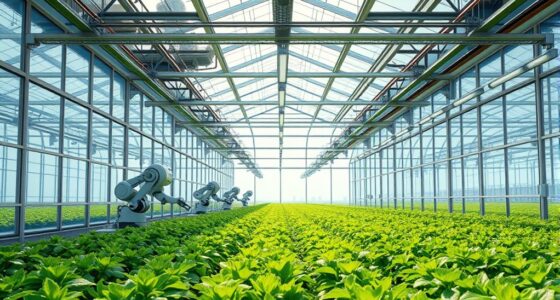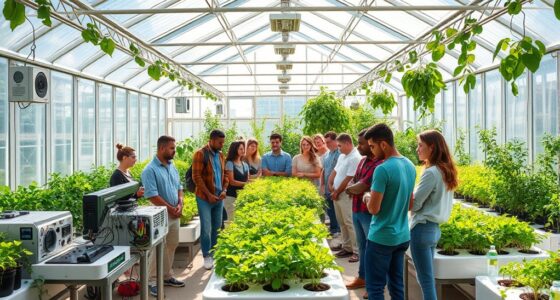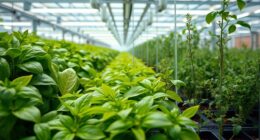AI plays a crucial role in modern greenhouse management by optimizing resource usage, climate control, and pest management. With AI, you can cut water consumption by up to 10% and reduce energy costs by 16%. It predicts irrigation needs, maintains ideal climate conditions, and detects pests early, supporting sustainable practices. As you implement these technologies, you'll enhance productivity and efficiency. Discover how AI can further transform your greenhouse operations with innovative solutions.
Key Takeaways
- AI enhances greenhouse efficiency by predicting maintenance needs and foreseeing equipment failures through sensor data analysis.
- Climate control is optimized with AI, using localized weather data to adjust heating, cooling, and ventilation for ideal plant growth.
- Resource efficiency improves as AI optimizes irrigation, reducing water usage and energy consumption while managing nutrient mixes for better yields.
- AI-driven systems enable early pest and disease detection, minimizing chemical pesticide use and promoting sustainable biological control methods.
- Digital Twin technology integrates AI and real-time data, simulating scenarios for better decision-making and resource allocation in greenhouse operations.
Transforming Greenhouse Operations With AI
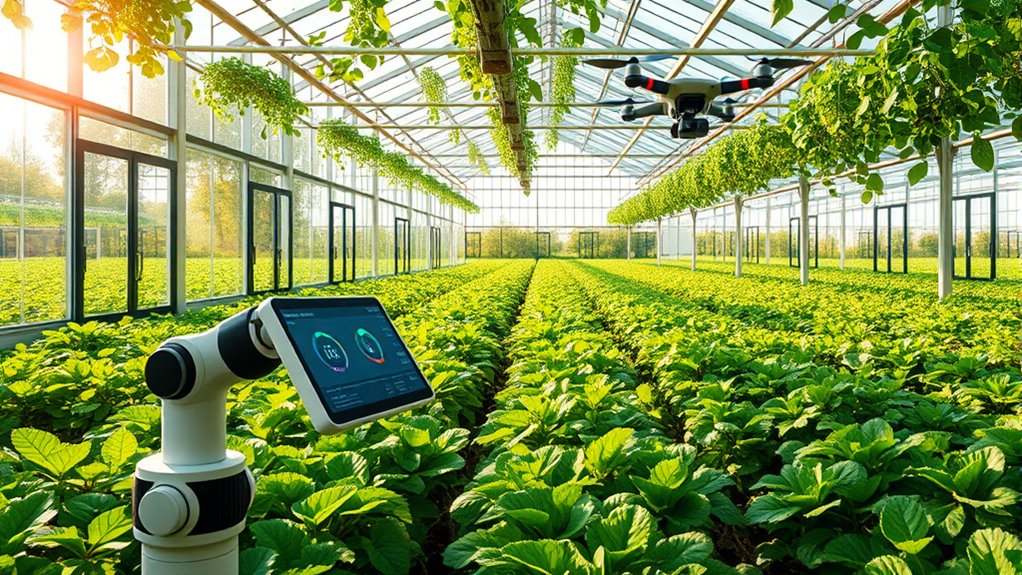
As you embrace AI in greenhouse management, you'll discover how it transforms operations by enhancing efficiency and productivity.
With predictive maintenance, AI analyzes sensor data to foresee equipment failures, allowing you to schedule maintenance proactively. You'll also optimize resource usage, as AI predicts irrigation needs based on plant growth stages and weather conditions. Additionally, AI-driven climate control ensures optimal humidity levels are maintained, promoting plant health and reducing the risk of disease. This also parallels the benefits seen in air purifier technology, which enhances indoor environments for respiratory health. The integration of emerging technologies in agriculture is revolutionizing how we approach food production. By adopting a growth mindset, you can further leverage AI to continually improve your greenhouse practices.
Disease and pest detection becomes streamlined through AI-powered image recognition, enabling quick interventions. Automated systems integrate with watering and lighting setups to maintain ideal growth conditions.
Finally, data-driven decision-making empowers you to analyze vast datasets, providing insights that optimize your greenhouse operations for better outcomes. Embracing these AI advancements guarantees you stay ahead in modern agricultural practices.
Enhancing Climate Control and Optimization
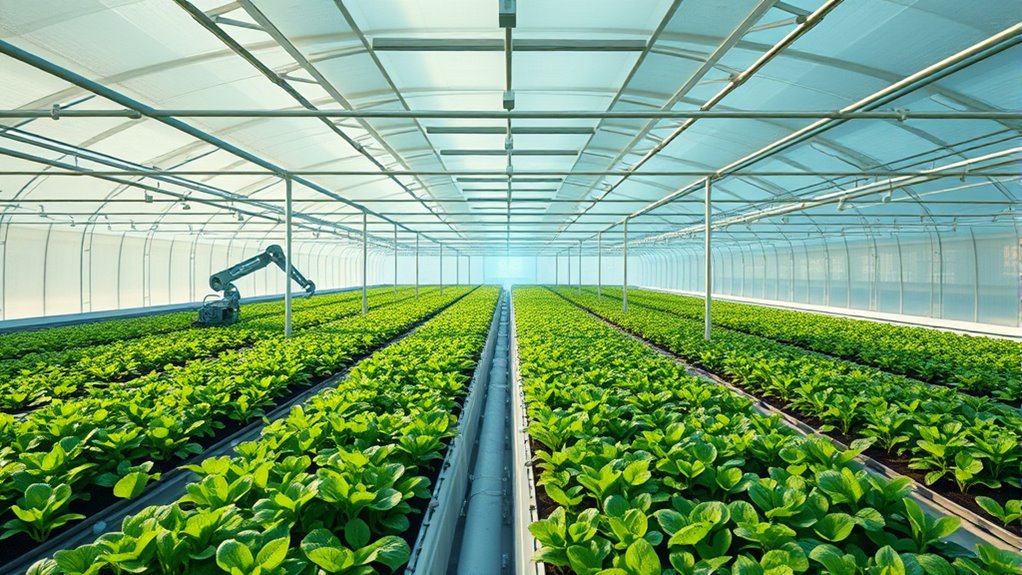
AI advancements not only enhance operational efficiency but also markedly improve climate control in greenhouses.
With AI-driven climate control systems, you can predict and optimize conditions using localized weather data, creating a three-day climate strategy. These predictive models reduce energy consumption by fine-tuning heating and cooling needs, ensuring stable temperature and humidity levels that lower disease risks. Furthermore, AI positively influences energy efficiency in various sectors, making it a crucial component in modern agricultural practices. Additionally, implementing proper watering techniques ensures that plants receive the right amount of hydration, which is vital for their growth. Geothermal heat pumps, for example, can achieve efficiency ratings of 300% to 600%, further enhancing energy savings in greenhouse operations. Heat pumps can reduce energy bills by up to 50%, making them a worthwhile investment for sustainable practices.
Implementing digital twin technology allows you to simulate various scenarios, adjusting settings to see effects before actual changes.
Furthermore, AI optimizes ventilation and CO₂ management, maintaining ideal levels for plant growth while conserving resources. This dynamic approach translates into consistently healthy crops and extended equipment lifespan, making your greenhouse operations more effective and sustainable.
Driving Resource Efficiency and Sustainability

While traditional greenhouse practices often lead to resource waste, leveraging advanced technology can transform operations into models of efficiency and sustainability.
By utilizing AI, you can optimize irrigation, reducing water usage by up to 10% while ensuring plants receive the right amount of moisture. AI also manages energy consumption, cutting heating and cooling costs by up to 16%. Furthermore, AI analyzes soil moisture levels and plant transpiration to deliver precise irrigation, ensuring optimal growing conditions. Additionally, the integration of AI in agriculture is projected to enhance overall productivity and sustainability. Moreover, solar energy solutions can be incorporated to power greenhouse operations, further promoting sustainability. Using wood stoves for heating can also contribute to eco-friendly practices within greenhouse management.
With precise nutrient management, you can adjust mixes based on real-time data, improving crop yields and minimizing waste. These innovations not only enhance resource allocation but also lower operational costs, making your greenhouse more sustainable.
Ultimately, embracing AI-driven systems supports long-term viability and reduces your environmental footprint, creating a more efficient and eco-friendly greenhouse operation.
Advanced Pest and Disease Management

Effective pest and disease management is essential for maintaining healthy crops in greenhouses, and integrating advanced technologies can greatly enhance your approach.
AI-driven systems, like deep learning models, enable early detection of pests and diseases, allowing you to take proactive measures. By utilizing computer vision, you can replace manual scouting with real-time monitoring, which boosts efficiency and accuracy. These systems also minimize chemical pesticide use, supporting more sustainable biological control methods. With AI analyzing pest population dynamics, you gain actionable insights that help you make informed decisions, ultimately optimizing yields and reducing costs. Moreover, embracing solar energy solutions can help power your greenhouse operations sustainably, further enhancing productivity. Additionally, understanding the refrigeration cycle can aid in creating optimal environmental conditions within the greenhouse, ensuring the best possible growth for your crops. Furthermore, recognizing the impact of foraging behavior in pollination can enhance the overall health of the greenhouse ecosystem.
Embracing these advanced pest management techniques won't only protect your crops but also enhance your overall greenhouse productivity.
Leveraging Digital Twins for Improved Decision Making
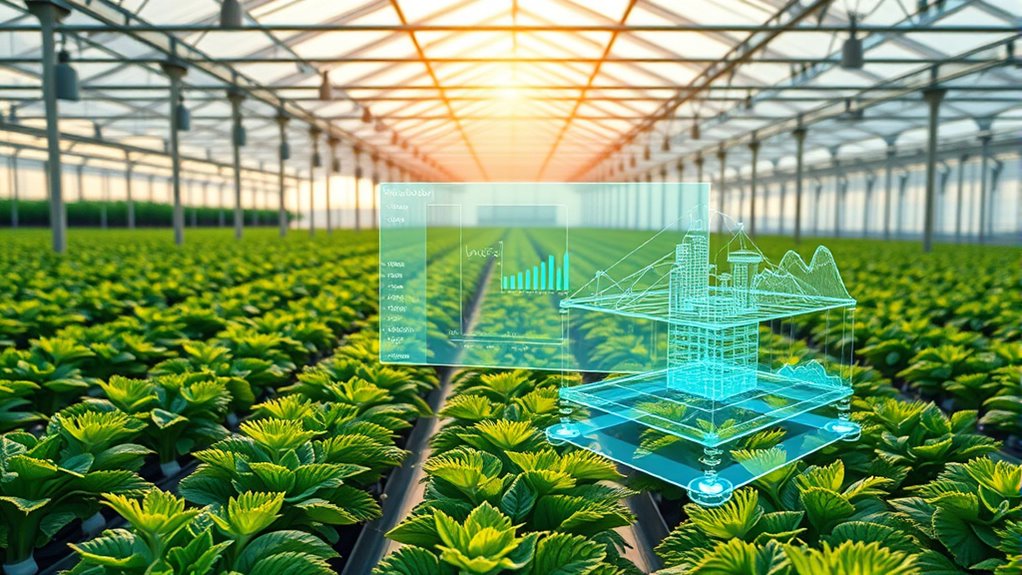
As greenhouse managers seek to enhance their operations, leveraging Digital Twins can transform decision-making processes. These virtual replicas allow you to simulate various scenarios, helping you optimize resource allocation and climate management.
By integrating AI, Digital Twins harness real-time data from sensors and IoT devices, enabling you to make informed, data-driven decisions. This technology not only reduces energy consumption and CO2 emissions but also promotes cost efficiency by allowing you to purchase energy at lower rates. Additionally, digital agriculture supports predictive maintenance, helping you anticipate issues before they arise. Consequently, the use of Digital Twins can lead to enhanced customer satisfaction by ensuring that the products meet quality standards. Furthermore, implementing predictive modeling can further optimize your greenhouse operations by forecasting potential challenges and opportunities. Ultimately, utilizing Digital Twins can markedly improve your greenhouse's efficiency, sustainability, and overall productivity, making it an essential tool in modern greenhouse management. Moreover, adopting renewable energy sources for your greenhouse operations can further decrease your reliance on fossil fuels, benefiting both the environment and your operational costs.
Future Trends in AI-Driven Greenhouse Management

With the rapid advancements in AI technology, the future of greenhouse management promises to be more efficient and sustainable than ever.
You'll see real-time climate adjustments that optimize growing conditions, thanks to AI algorithms analyzing sensor data. Predictive modeling will help you anticipate climate patterns, allowing for proactive adjustments that enhance both plant growth and energy efficiency.
Imagine managing customized environments for diverse crops, all while reducing wear on equipment. AI will also transform resource management with precision irrigation and nutrient optimization, greatly cutting water and energy use. Additionally, automated solutions driven by AI will replace traditional methods, streamlining operations and increasing productivity. Furthermore, the integration of predictive analytics will empower growers to make informed decisions that mitigate risks associated with climate variability. As a result, many gardeners are discovering that backyard greenhouses can significantly benefit from these advancements. This shift towards automation is aligned with the principles of emergency preparedness, ensuring that growers can maintain stability in uncertain conditions.
Harness AI to create tailored environments for your crops while optimizing resource use and minimizing equipment strain.
Plus, early detection systems will enable you to tackle diseases and pests swiftly, ensuring consistent product quality and reducing environmental impact.
Embrace these innovations for a more productive greenhouse experience.
Frequently Asked Questions
How Can Small-Scale Growers Benefit From AI Technology?
You can benefit immensely from AI technology as a small-scale grower.
AI optimizes your growing conditions, ensuring your crops thrive while reducing water, energy, and chemical usage.
With automated monitoring and disease detection, you'll catch problems early and minimize losses.
AI also helps you predict market demands, enabling smarter planting decisions.
Ultimately, implementing AI can greatly boost your productivity and profitability, making your farming operations more sustainable and efficient.
What Initial Costs Are Associated With Implementing AI in Greenhouses?
Have you considered the upfront costs involved in implementing AI?
You'll face significant expenses, including advanced hardware like sensors and IoT devices.
Software development for customized AI models can also add to your budget.
Plus, training personnel with the necessary expertise is essential.
While these initial investments may seem overwhelming, they pave the way for increased efficiency and improved crop yields in the long run.
Balancing costs with potential benefits is key.
Are There Specific AI Tools Recommended for Beginners?
If you're starting with AI in greenhouse management, consider tools like Plantix for quick disease identification and treatment recommendations.
GrowDirector offers extensive monitoring and automation features, perfect for beginners.
Climateye can help with weather forecasting, while FieldView uses satellite imagery to assess crop health.
These tools simplify the learning curve and allow you to focus on enhancing your greenhouse efficiency without overwhelming complexity.
Start small, and build your expertise gradually.
How Does AI Impact Labor Requirements in Greenhouse Operations?
AI considerably impacts labor requirements in greenhouse operations by automating repetitive tasks like planting and harvesting.
You'll notice a shift from manual labor to more strategic roles, as AI allows you to focus on monitoring systems and making complex decisions.
With AI streamlining processes and enhancing productivity, it reduces the need for large labor forces, helping you manage resources more efficiently while ensuring continuous operations despite labor shortages.
What Are Potential Challenges in Adopting AI for Greenhouse Management?
When adopting AI for greenhouse management, you'll face several challenges.
Integrating AI with legacy systems can be complex and costly, and ensuring data quality is essential for effective decision-making.
You might also struggle with the initial investment costs and the need for specialized skills.
Balancing automation with human oversight is important, and you'll need to address cybersecurity risks to protect your operations from potential vulnerabilities.
Conclusion
Incorporating AI into greenhouse management isn't just a trend; it's a transformative shift that enhances efficiency, sustainability, and decision-making. As you embrace these technologies, you're not only optimizing climate control and resource use but also paving the way for innovative pest management strategies. Isn't it time you considered how AI can revolutionize your greenhouse operations? The future of agriculture is here, and with AI at your side, you're well-equipped to thrive in a competitive market.



